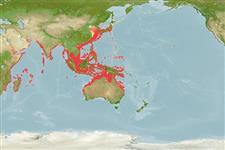Classification / Names
Common names from other countries
Main reference
Size / Weight / Age
Max length : 145 cm FL male/unsexed; (Ref. 40637); common length : 70.0 cm FL male/unsexed; (Ref. 168); max. published weight: 35.9 kg (Ref. 168)
Environment
Marine; pelagic-neritic; oceanodromous (Ref. 51243); depth range 10 - ? m
Climate / Range
Tropical, preferred 28°C (Ref. 107945); 47°N - 31°S, 34°E - 154°E (Ref. 54923)
Distribution
Short description
Vertebrae: 39. A small species, deepest near the middle of the first dorsal fin base. The second dorsal fin is higher than the first dorsal fin; the pectoral fins are short to moderately long; swim bladder is absent or rudimentary. Lower sides and belly silvery white with colorless elongate oval spots arranged in horizontally oriented rows. The dorsal, pectoral and pelvic fins are blackish; the tip of the second dorsal and anal fins are washed with yellow; the anal fin is silvery; the dorsal and anal finlets are yellow with grayish margins; the caudal fin is blackish, with streaks of yellow green.
IUCN Red List Status (Ref. 115185)
Threat to humans
Harmless
Human uses
Fisheries: highly commercial; gamefish: yes
Tools
Special reports
Download XML
Internet sources
Estimates of some properties based on models
Phylogenetic diversity index
PD50 = 0.5039 many relatives (e.g. carps) 0.5 - 2.0 few relatives (e.g. lungfishes)
Trophic Level
4.5 ±0.6 se; Based on diet studies.
Resilience
Medium, minimum population doubling time 1.4 - 4.4 years (K=0.32; assuming tm=2-4)
Vulnerability
Moderate to high vulnerability (47 of 100)
Price category
